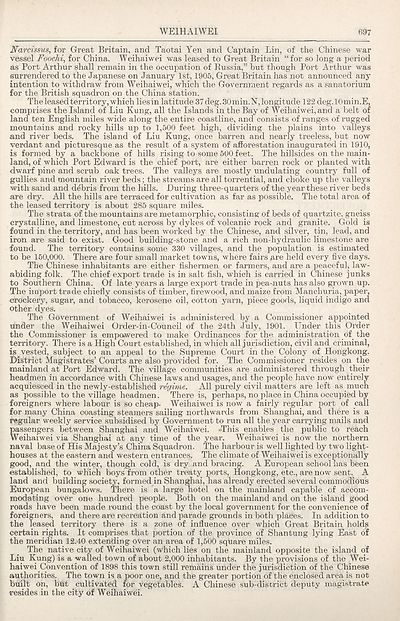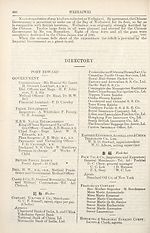1918
(771) Page 697
Download files
Complete book:
Individual page:
Thumbnail gallery: Grid view | List view

WEIHAIWEI
697
Narcissus, for Great Britain, and Taotai Yen and Captain Lin, of the Chinese war
vessel Foochi, for China. Weihaiwei was leased to Great Britain “for so long a period
as Port Arthur shall remain in the occupation of Russia,” but though Port Arthur was
surrendered to the Japanese on January 1st, 1905, Great Britain has not announced any
intention to withdraw from Weihaiwei, which the Government regards as a sanatorium
for the British squadron on the China station.
The leased territory, which lies in latitude 37 deg. 30 min.N, longitude 122 deg. 10 min.E,
comprises the Island of Liu Kung, all the Islands in the Bay of Weihaiwei, and a belt of
land ten English miles wide along the entire coastline, and consists of ranges of rugged
mountains and rocky hills up to 1,500 feet high, dividing the plains into valleys
and river beds. The island of Liu Kung, once barren and nearly treeless, but now
verdant and picturesque as the result of a system of afforestation inaugurated in 1910,
is formed by a backbone of hills rising to some 500 feet. The hillsides on the main¬
land, of which Port Edward is the chief port, are either barren rock or planted with
dwarf pine and scrub oak trees. The valleys are mostly undulating country full of
gullies and mountain river beds; the streams are all torrential, and choke up the valleys
with sand and debris from the hills. During three-quarters of the year these river beds
are dry. All the hills are terraced for cultivation as far as possible. The total area of
the leased territory is about 285 square miles.
The strata of the mountains are metamorphic, consisting of beds of quartzite, gneiss
crystalline, and limestone, cut across by dykes of volcanic rock and granite. Gold is
found in the territory, and has been worked by the Chinese, and silver, tin, lead, and
iron are said to exist. Good building-stone and a rich non-hydraulic limestone are
found. The territory contains some 330 villages, and the population is estimated
to be 150,000. There are four small market towns, where fairs gre held every five days.
The Chinese inhabitants are either fishermen or farmers, and are a peaceful, law-
abiding folk. The chief export trade is in salt fish, which is carried in Chinese junks
to Southern China. Of late years a large export trade in pea-nuts has also grown up.
The import trade chiefly consists of timber, firewood, and maize from Manchuria, paper,
crockery, sugar, and tobacco, kerosene oil, cotton yarn, piece goods, liquid indigo and
other dyes.
The Government of Weihaiwei is administered by a Commissioner appointed
under the Weihaiwei Order-in-Council of the 24th July, 1901. Under this Order
the Commissioner is empowered to make Ordinances for the administration of the
territory. There is a High Court established, in which all jurisdiction, civil and criminal,
in vested, subject to an appeal to the Supreme Court in the Colony of Hongkong.
District Magistrates’ Courts are also provided for. The Commissioner resides on the
mainland at Port Edward. The village communities are administered through their
headmen in accordance with Chinese laws and usages, and the people have now entirely
acquiesced in the newly-established regime. All purely civil matters are left as much
as possible to the village headmen. There is, perhaps, no place in. China occupied by
foreigners where labour is so cheap. Weihaiwei is now a fairly regular port of call
for many China coasting steamers sailing northwards from Shanghai, and there is a
regular weekly service subsidised by Government to run all the year carrying mails and
passengers between Shanghai and Weihaiwei. -This enables the public to reach
Weihaiwei via Shanghai at any time of the year. Weihaiwei is now the northern
naval base of His Majesty’s China Squadron. The harbour is well lighted by two light¬
houses at the eastern and western entrances. The climate of Weihaiwei is exceptionally
good, and the winter, though cold, is dry and bracing. A European school has been
established, to which boys from other treaty ports, Hongkong, etc., are now sent. A
land and building society, formed in Shanghai, has already erected several commodious
European bungalows. There is a large hotel on the mainland capable of accom¬
modating over one hundred people. Both on the mainland and on the island good
roads have been made round the coast by the local government for the convenience of
foreigners, and there are recreation and parade grounds in both places. In addition to
the leased territory there is a zone of influence over which Great Britain holds
certain rights. It comprises that portion of the province of Shantung lying East of
the meridian 12.40 extending over an area of 1,500 square miles.
The native city of Weihaiwei (which lies on the mainland opposite the island of
Liu Kung) ;is a walled town of about 2,000 inhabitants. By the provisions of the Wei¬
haiwei Convention of 1898 this town still remains under the jurisdiction of the Chinese
authorities. The town is a poor one, and the greater portion of the enclosed area is not
built on, but cultivated for vegetables. A Chinese sub-discrict deputy magistrate
resides in the city of Weihaiwei.
697
Narcissus, for Great Britain, and Taotai Yen and Captain Lin, of the Chinese war
vessel Foochi, for China. Weihaiwei was leased to Great Britain “for so long a period
as Port Arthur shall remain in the occupation of Russia,” but though Port Arthur was
surrendered to the Japanese on January 1st, 1905, Great Britain has not announced any
intention to withdraw from Weihaiwei, which the Government regards as a sanatorium
for the British squadron on the China station.
The leased territory, which lies in latitude 37 deg. 30 min.N, longitude 122 deg. 10 min.E,
comprises the Island of Liu Kung, all the Islands in the Bay of Weihaiwei, and a belt of
land ten English miles wide along the entire coastline, and consists of ranges of rugged
mountains and rocky hills up to 1,500 feet high, dividing the plains into valleys
and river beds. The island of Liu Kung, once barren and nearly treeless, but now
verdant and picturesque as the result of a system of afforestation inaugurated in 1910,
is formed by a backbone of hills rising to some 500 feet. The hillsides on the main¬
land, of which Port Edward is the chief port, are either barren rock or planted with
dwarf pine and scrub oak trees. The valleys are mostly undulating country full of
gullies and mountain river beds; the streams are all torrential, and choke up the valleys
with sand and debris from the hills. During three-quarters of the year these river beds
are dry. All the hills are terraced for cultivation as far as possible. The total area of
the leased territory is about 285 square miles.
The strata of the mountains are metamorphic, consisting of beds of quartzite, gneiss
crystalline, and limestone, cut across by dykes of volcanic rock and granite. Gold is
found in the territory, and has been worked by the Chinese, and silver, tin, lead, and
iron are said to exist. Good building-stone and a rich non-hydraulic limestone are
found. The territory contains some 330 villages, and the population is estimated
to be 150,000. There are four small market towns, where fairs gre held every five days.
The Chinese inhabitants are either fishermen or farmers, and are a peaceful, law-
abiding folk. The chief export trade is in salt fish, which is carried in Chinese junks
to Southern China. Of late years a large export trade in pea-nuts has also grown up.
The import trade chiefly consists of timber, firewood, and maize from Manchuria, paper,
crockery, sugar, and tobacco, kerosene oil, cotton yarn, piece goods, liquid indigo and
other dyes.
The Government of Weihaiwei is administered by a Commissioner appointed
under the Weihaiwei Order-in-Council of the 24th July, 1901. Under this Order
the Commissioner is empowered to make Ordinances for the administration of the
territory. There is a High Court established, in which all jurisdiction, civil and criminal,
in vested, subject to an appeal to the Supreme Court in the Colony of Hongkong.
District Magistrates’ Courts are also provided for. The Commissioner resides on the
mainland at Port Edward. The village communities are administered through their
headmen in accordance with Chinese laws and usages, and the people have now entirely
acquiesced in the newly-established regime. All purely civil matters are left as much
as possible to the village headmen. There is, perhaps, no place in. China occupied by
foreigners where labour is so cheap. Weihaiwei is now a fairly regular port of call
for many China coasting steamers sailing northwards from Shanghai, and there is a
regular weekly service subsidised by Government to run all the year carrying mails and
passengers between Shanghai and Weihaiwei. -This enables the public to reach
Weihaiwei via Shanghai at any time of the year. Weihaiwei is now the northern
naval base of His Majesty’s China Squadron. The harbour is well lighted by two light¬
houses at the eastern and western entrances. The climate of Weihaiwei is exceptionally
good, and the winter, though cold, is dry and bracing. A European school has been
established, to which boys from other treaty ports, Hongkong, etc., are now sent. A
land and building society, formed in Shanghai, has already erected several commodious
European bungalows. There is a large hotel on the mainland capable of accom¬
modating over one hundred people. Both on the mainland and on the island good
roads have been made round the coast by the local government for the convenience of
foreigners, and there are recreation and parade grounds in both places. In addition to
the leased territory there is a zone of influence over which Great Britain holds
certain rights. It comprises that portion of the province of Shantung lying East of
the meridian 12.40 extending over an area of 1,500 square miles.
The native city of Weihaiwei (which lies on the mainland opposite the island of
Liu Kung) ;is a walled town of about 2,000 inhabitants. By the provisions of the Wei¬
haiwei Convention of 1898 this town still remains under the jurisdiction of the Chinese
authorities. The town is a poor one, and the greater portion of the enclosed area is not
built on, but cultivated for vegetables. A Chinese sub-discrict deputy magistrate
resides in the city of Weihaiwei.
Set display mode to:
![]() Universal Viewer |
Universal Viewer | ![]() Mirador |
Large image | Transcription
Mirador |
Large image | Transcription
Images and transcriptions on this page, including medium image downloads, may be used under the Creative Commons Attribution 4.0 International Licence unless otherwise stated. ![]()
| Asian directories and chronicles > 1918 > (771) Page 697 |
|---|
| Permanent URL | https://digital.nls.uk/194903353 |
|---|
| Attribution and copyright: |
|
|---|---|
| Description | Volumes from the Asian 'Directory and Chronicle' series covering 1917-1941, but missing 1919 and 1923. Compiled annually from a multiplicity of local sources and research. They provide listings of each country's active corporations, foreign residents and government agencies of all nationalities for that year, together with their addresses. Content includes: various treaties; coverage of conflicts; currencies and taxes; consular fees; weights and measures; public holidays; festivals and traditions. A source of information for both Western states and communities of foreigners living in Asia. Published by Hongkong Daily Press. |
|---|---|
| Shelfmark | H3.86.1303 |
| Additional NLS resources: |
![[Page 696]Lungkow -- Weihaiwei](https://deriv.nls.uk/dcn4/1949/0334/194903342.4.jpg)
